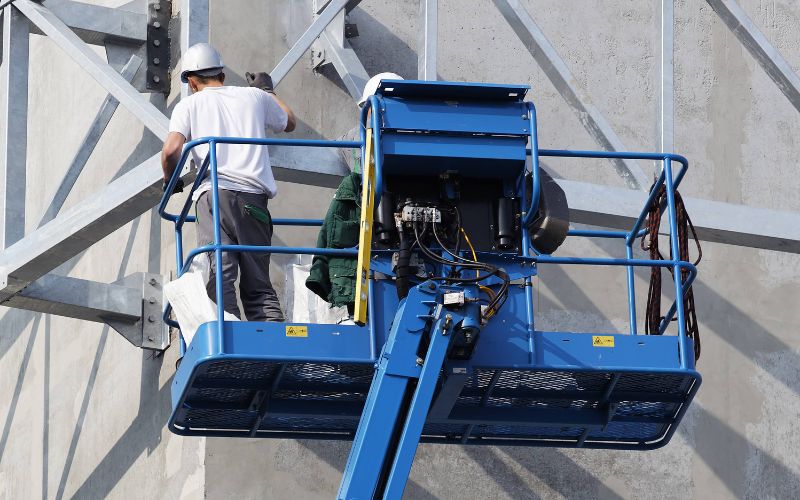Using a Boom Lift on a slope or incline requires a strong focus on safety, as these conditions can present unique challenges. Whether you’re in construction, maintenance, or any other field that uses an Elevating Work Platform (EWP), it’s essential to approach these situations with a well-thought-out strategy.
In this blog, we’ve revealed the best practices for safely operating a Boom Lift on a slope or incline. With these tips, you can ensure your safety and the safety of those around you.
Understanding Boom Lifts
Before starting, it’s important to familiarise yourself with the machinery. Boom lifts aren’t all the same; they have various models for different applications and environments.
1. Telescopic Boom Lifts
These are the most common type and can extend horizontally and vertically, offering a high reach for tasks such as overhead construction or building maintenance.
2. Articulating Boom Lifts
Ideal for navigating obstacles, these lifts have upper and lower boom arms that allow them to maneuver up and over barriers.
3. Towable Boom Lifts
These smaller lifts are designed for ease of transport towed behind a vehicle and are often used in tasks like tree clearing or painting.
Each type of boom lift has its own components, such as platform weighing, hydraulic pressure sensors, and position switches all of which contribute to the safety and functionality of the machine.
To learn more about boom lift prices and models, contact us today!
The Importance of Pre-Operation Safety Checks
Before using an EWP, it’s essential to conduct a thorough pre-operation inspection. This ensures that the equipment is safe to use, especially on a slope.
Equipment Inspection
Check the booms wheels for wear or damage, the boom structure for any irregularities, and the hydraulics for leaks. Ensure that the chassis and platform are in good working condition and function correctly.
Worksite Assessment
Assess the ground where the lift will be driven and operated. Ensure it’s stable enough to support the booms weight and free of potholes or debris. Under the ground, look for signs of recent excavation, where the soil could be loose and soft, tunnels & drains which may collapse. Overhead hazards, such as power lines or trees, should also be considered, and the weather conditions must be suitable for operation. Power Line safe distances must be observed by the operator, and a spotter used on the ground to alert operator of any dangers.
Personal Protective Equipment (PPE)
Wearing the correct PPE is non-negotiable when working with boom lifts, as proper gear helps reduce the risk of injury. Harnesses must be worn.
Remember, regular maintenance of your PPE is just as crucial as ensuring it’s worn. If damaged PPE should be replaced immediately.
Operating the Boom Lift
When it comes to operating a boom lift, especially on a slope or incline, proper technique is essential to avoid accidents.
Starting Procedures and Familiarisation
Always read the operator’s manual and familiarise yourself with the controls before starting the machine. Ensure when operating the boom lift it is on a slope within the manufacturer’s recommended gradient.
Log Book
Check the boom lifts logbook to ensure the service date is within 90 days and there is no faults recorded that have not been repaired. After pre-operation inspection, operator to sign off that the inspection was correctly completed, every day.
Maneuvering Techniques
Whether you’re raising, lowering, or rotating the platform, it’s essential to operate the boom lift slowly and cautiously. Operators should refrain from any abrupt actions that could cause the lift to destabilise.
Emergency Protocols
Make sure you know where the emergency stop button is located. If the lift starts to act erratically, immediately shut it down and inspect it for any issues before continuing operations.
Advanced Safety Techniques
As you become more experienced with boom lifts, you’ll need to implement advanced safety techniques, especially when navigating uneven terrain like slopes.
Load Management
Do not overload the platform and place the load evenly in the platform. People, tools and all other items in platform must not be more than the SWL.
Navigating Slopes and Uneven Terrain
When operating a boom lift on an incline, stay within the limits and do not drive elevated, wherever possible. Keep all wheels on the same level when elevated, do not drive elevated over uneven terrain.
Site Inspection
Ensure a risk assessment is completed to assess all the hazards present.
Including ground conditions, traffic, power lines, overhead objects and projections
Common Mistakes and How to Avoid Them
It’s easy to make mistakes when using a boom lift, but being aware of common issues can help you avoid accidents.
Overloading the Platform
Never exceed the recommended weight limit. This can cause instability and may lead to a tipping accident.
Not Checking Ground Conditions
Boom lifts need solid ground to operate, if a wheel sinks in mud or a concealed drain, the boom could tip over.
Bypassing Safety Checks
It’s tempting to skip equipment checks when you’re in a rush, but this can be deadly. Always inspect the lift before each use, even if it’s just been serviced.
Training and Certification
Operating a boom lift safely isn’t just about having the right equipment; it’s about knowing how to use it correctly. That’s why training and certification are essential.
Operator Training and Certification Programs
Verifiction of Compentancy (VOC), EWP Yellow Card and High Risk Licenses ensure that all operators receive proper training. Training will help everyone understand the equipment and recognise potential hazards before they cause problems and typically cover safety regulations, equipment handling, and emergency procedures.
Conclusion:
Ultimately, keeping safe when using a boom lift on a slope or incline comes down to being responsible and carefully following the safety rules. By following the few safety measures mentioned in this blog, conducting thorough pre-operation checks, using the right PPE, and practising advanced safety techniques, you can ensure that you and your team stay safe on the job.
To learn more about safety precautions, call Access Service Australia on 1300 272 111.

